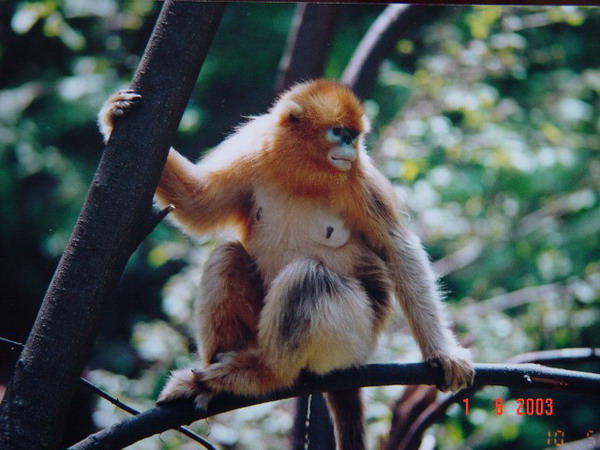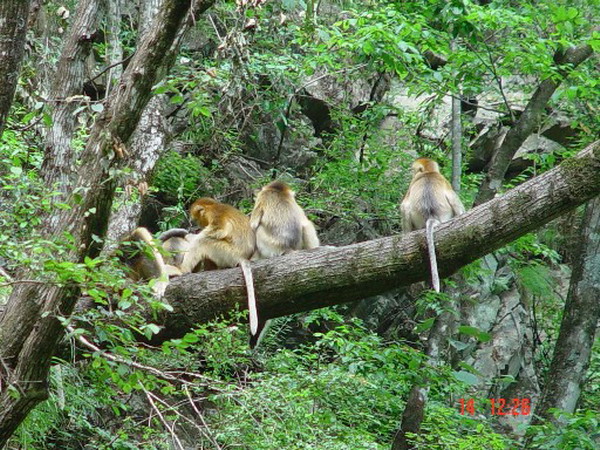The genus of snub-nosed monkeys (Rhinopithecus, Colobinae, Cercopithecidae) comprises four species, three of which are endemic to China (the golden or Sichuan snub-nosed monkey, R. roxellana; the black or Yunnan snub-nosed monkey, R. bieti; and the Gray or Guizhou snub-nosed monkey, R. brelichi). The fourth is only distributed in northern Vietnam (Tonkin’s snub-nosed monkey, R. avunculus). In history, Rhinopithecus were widely distributed in the southern China and northwest part of China (including Shanxi province and Gansu province). However, habitat loss caused the extinction of Rhinopithecus groups in many original regions. Because Rhinopithecus groups are mainly distributed in isolated “islanded” fragmentation forests in Yunnan, Tibet, Guizhou, Shanxi, Sichuan, Gansu and Hubei provinces at present, all the groups of Rhinopithecus are becoming endangered. In order to assess the current survival conditions of the Rhinopithecus and provide scientific conservation strategies, the research group in the Key Laboratory of Animal Ecology and Conservation Biology of Institute of Zoology (IOZ), Chinese Academy of Sciences (CAS), has conducted studies on the behavioral ecology, population genetics and conservation genetics of the three Rhinopithecus species for some years in China.
Systematic classification and phylogenetic relationship of Genus Rhinopithecus has been controversial for a long time, so the research group clarified the relationships among all species based on molecular systematics. These results indicated that four species within Genus Rhinopithecus are valid taxa and populations of R. roxellana in different geographical areas should not be regarded as subspecies.
The research group has conducted a continuous behavioral ecological study on a group of R. bieti at Xiangguqing over one year. Researchers found that these monkeys form a super natural group whose home range is 15-km²instead of less than 5-km²before. Unfortunately, the home range size cannot support such super group for a long time. How to keep this group remain in this place is a big problem in conservation. Shall we keep this group alone or split it by human interference? If human interference is necessary, it is necessary to understand how the group splits and transfers subgroups. Solutions of this problem shall be based on in-depth research on population structure, social organization and behaviors.
In the research aspect of population genetics and conservation genetics of R. bieti, some molecular markers (Mitochondrial DNA control region and Microsatellite loci) were used to analysis with noninvasive samples. Results showed that R. bieti have experienced the uplift of Qinghai-Tibet plateau and warmer climatic phase during the last interglacial age. The moderate level of the genetic diversity indicates that R. bieti should not to be regarded as a taxon with low genetic diversity. Nowadays, habitat loss and human disturbance are main threats to R. bieti. Thus, sustainable development should be planned to reduce the pressure of human activities on the habitat of R. bieti. Additionally, results mentioned above suggest that [Northern Range], [Central and Southwest Range] and [Southeast Range] should be regarded as three Management Unit, and six populations in conservation are identified.
For another species R. roxellana, its populations are restricted to three isolated regions, Sichuan/Gansu region, Qinglin Mountain region and Shennongjia region. Phylogenetic analysis showed that R. roxellana in Sichuan/Gansu region might have older population history and then migrated eastward to Qinglin Mountain region and Shennongjia region. It should be appropriate to define Sichuan/Gansu, Qinglin Mountain, and Shennongjia as three management units according to the phylogeographic analysis and the significant genetic differentiation among those three regions. Finally, special attention should be paid to the conservation of the Shennongjia region because of its very low genetic diversity, small habitat area, and smaller population size.
The above-mentioned research results have been published in international scientific journals, such as Molecular Ecology, International Journal of Primatology, American Journal of Primatology, Conservation Genetics, Primates. Also, some of the results have been adopted by some relevant protection departments, such as State Forestry Administration in PRC, and The Nature Conservancy (TNC), USA. Especially for some distributions of R. bieti where the natural reserves have been not established, our results and suggestions will play key roles in programming and establishing the natural reserves for R. bieti.
In order to understand and compare the intraspecies and interspecies survival conditions within Rhinopithecus in China, the research group is setting up a study site for behavioral ecology and conservation genetics of Guizhou snub-nosed monkey in Fanjing Mountain, Guizhou Province. Also, the research group will focus on landscape genetics and adaptive evolution of some function gene among R. roxellana, R. brelichi and R. bieti in the future.



